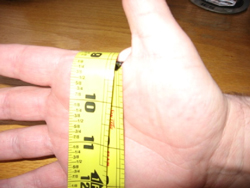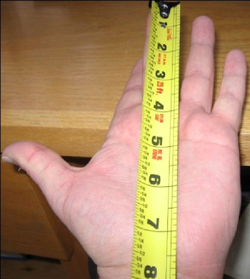While conducting electrical safety training one day I had an electrician complain that he hated the electrical insulated gloves he was wearing: “I can’t work with these gloves—they don’t fit and they’re uncomfortable!” Electrical rubber insulating gloves provide significant protection for electrical workers. Shock protection is the primary benefit; however; electrical rubber insulating gloves also provide significant burn protection in the event of an arc flash. It is very important the leather protectors are worn over electrical rubber insulating gloves—this provides protection against cuts and nicks caused by contact with electrical components.
Proper Fitting for Electrical Gloves
Back to the electrician who complained about wearing electrical gloves. I asked him if he had been fitted for the gloves. He informed me his boss bought one size and distributed the gloves to all the electricians. To ensure proper fit and dexterity, everyone using electrical gloves needs to be fitted. The correct fitting method is taking your dominant hand and measuring the circumference of the largest portion of your hand as well as measuring the middle finger to the base of your hand. The largest measurement (Size 7–11) is your glove size. Refer to the photos below for assistance.


Daily Inspection of the Gloves
Prior to wearing, electrical rubber gloves need to be inspected to ensure they are safe for use:
Visual inspection: Handle both gloves to ensure they don’t feel tacky. Also, check for swelling as this may indicate contact with a petroleum product. Also, check the gloves for nicks. In addition, inspect between fingers for possible ozone damage. Finally, inspect the leather protectors to ensure there are no cuts in the leather and no sharp objects embedded in the leather.
Air Test: Inflate the gloves and hold them up to your cheek—check for air leaks.
Dielectric Testing of Gloves
In addition to daily testing, every 6 months rubber insulating gloves must be dielectrically tested. This is required by NFPA 70E® [Table 130.7 (C)(6)(c)] as well as OSHA 1910.137 (Table I-6). The gloves are exposed to an electrical charge. Gloves passing the test will have the test date stamped on the gloves. Failed gloves will have the failure section highlighted and cutout to avoid reuse.
Glove Use and Storage
Proper glove use and storage is essential to ensure safe glove use. Always follow these practices:
Glove Storage: Always place gloves cuff down in their storage bags—this will keep debris from entering gloves. Also, when placing gloves in storage bag, separate rubber gloves from leather protectors—this will make you more likely to inspect the gloves prior to use. In addition, store the gloves in a cool, dry location to protect the rubber.
Cleaning: Use lukewarm water and mild soap detergent. Use no solvents, oil, or grease.
Protection from Perspiration: If you need dust to minimize sweat inside the rubber glove avoid any product containing talc as it can degrade the rubber insulation. Instead, use a glove powder approved by the manufacturer or use liners that absorb perspiration.
Summary
As stated previously, rubber insulated gloves are a great asset for electrical workers. The first step is being fitted properly and being issued the proper glove. It is also vitally important that gloves be inspected prior to use and stored properly.
If you have any questions concerning this article or other safety issues, please contact W. Jon Wallace, “The Safety Guru”, at 919.933.5548 or by e-mail

